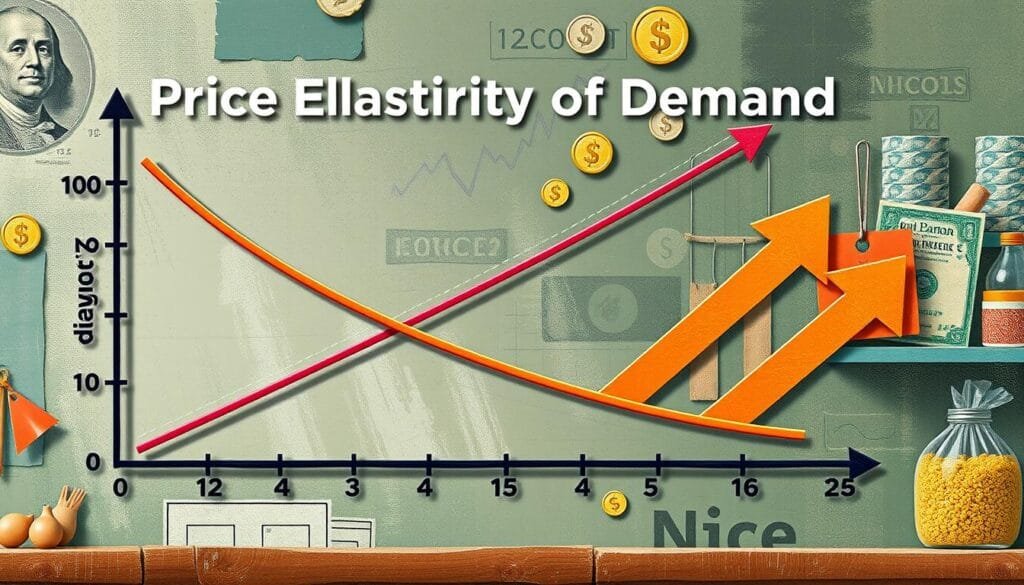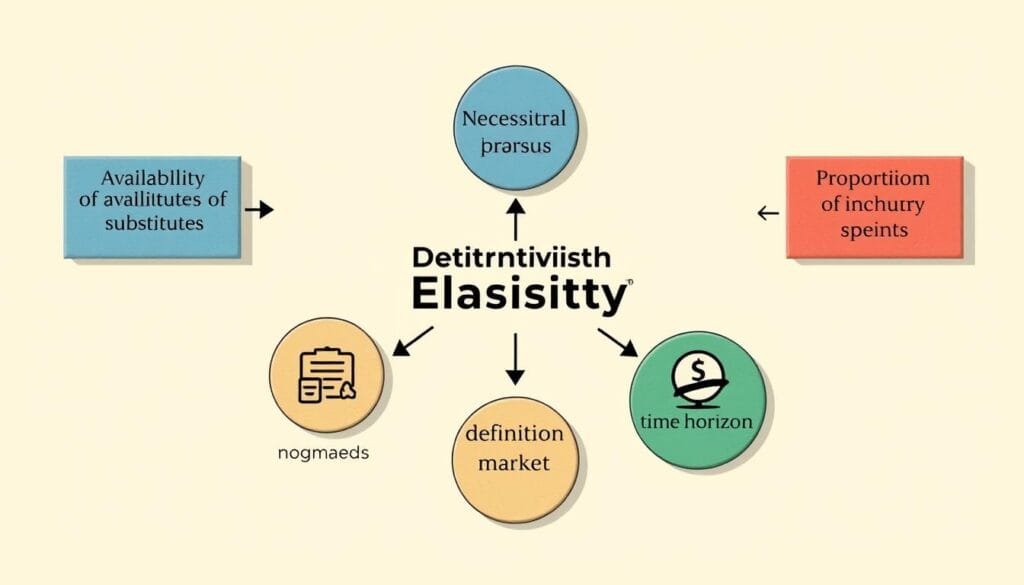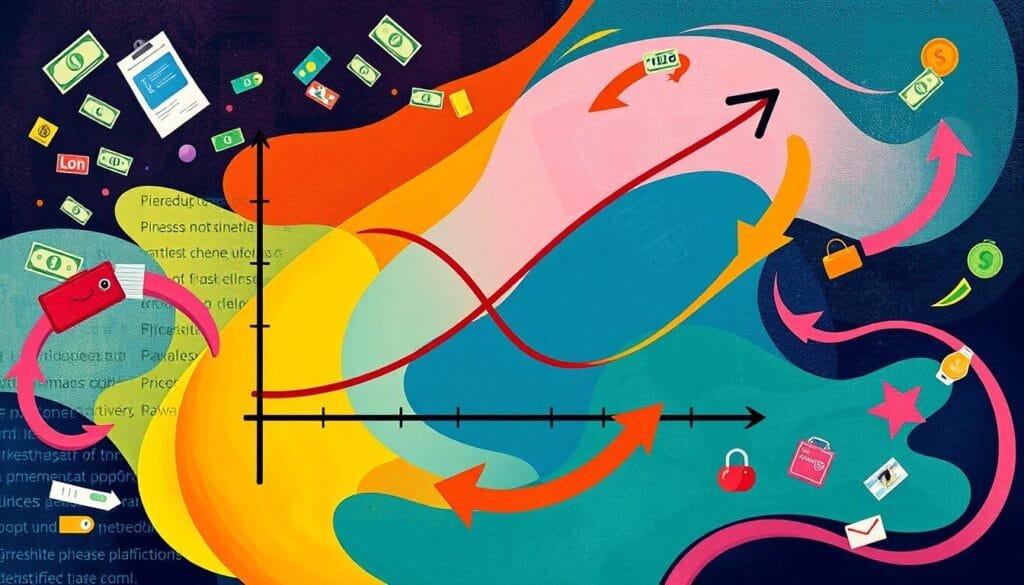Have you ever noticed how some products sell quickly after just a small price drop, while others don’t? This is where economic elasticity comes into play. It helps us understand price responsiveness and demand fluctuation.
Elasticity in economics looks at how changes in one area affect another. This concept helps companies adjust their prices, supply, and marketing. Knowing about elasticity lets businesses predict how price changes, income shifts, or new options will change consumer habits.
Items that are considered elastic react sharply to price changes. On the contrary, inelastic goods keep a stable demand despite price moves. Essentials like healthcare and gasoline are inelastic. Meanwhile, luxuries and non-essentials, like spa visits, are elastic. Economic changes, such as those from COVID-19, show why understanding elasticity is key.
Key Takeaways
- Economic elasticity measures the responsiveness of one variable to changes in another.
- Price fluctuations significantly affect the demand for elastic goods but have little effect on inelastic goods.
- Essentials like gasoline and healthcare generally exhibit inelastic demand.
- Businesses use elasticity to strategize pricing, supply, and marketing.
- Recent economic events underscore the importance of understanding elasticity in market dynamics.
Introduction to Elasticity
In economics, elasticity is key. It shows how demand or supply changes with price, income, or substitutes. It’s essential for economic planning and market strategies. It shapes how businesses and economists react to market changes.
Definition of Elasticity
Elasticity definition can differ based on its use. Mainly, it’s how much demand changes with price changes. It is shown as:
Price elasticity of demand = Percent change in demand / Percent change in price.
Elasticity usually gets a negative value because demand goes down when prices go up. But, it’s shown in positive numbers for simplicity. For example, if elasticity is 3, a 1% price hike leads to a 3% drop in demand.
Importance of Elasticity in Economics
Elasticity is critical for many reasons. It predicts how markets react to price changes. With elastic demand, small price increases can reduce demand a lot. Inelastic demand doesn’t change much with price changes. Teenagers and low-income smokers, for example, are more affected by cigarette price changes than adult smokers.
Both governments and businesses use elasticity insights. Government raises taxes on cigarettes to reduce smoking and increase revenue. A 10% price rise leads to a 7% drop in smoking. Businesses use it to set prices that affect sales numbers. This helps them make better pricing decisions.
“A perfectly elastic demand situation would entail significant decreases in quantity demanded with minimal price increases, while a perfectly inelastic demand means quantity demanded remains constant despite price changes.”
| Good/Service | Price Increase | Change in Quantity Demanded | Elasticity |
|---|---|---|---|
| Cigarettess | 10% | -7% | 0.7 |
| Luxury Cars | 5% | -15% | 3.0 |
| Necessities | 8% | -2% | 0.25 |
Understanding market reactions through economic responsiveness and elasticity is vital. It shows how price and policy changes affect the market.
Types of Elasticity
In economics, understanding elasticity types is key. They help us see how price, income, and other changes affect what people buy and the market. Let’s dive into the main kinds: price elasticity of demand, income elasticity, cross elasticity, and price elasticity of supply.
Price Elasticity of Demand
Price elasticity of demand looks at how demand changes with price. The formula used is: Price elasticity of demand = Percentage change in quantity demanded / percentage change in price. When elasticity is high, even small price changes can make a big difference in demand. For example, lowering a product’s price from $10 to $8 might increase sales from 30 units to 50 units. This calculation is vital for competitive businesses to foresee how pricing affects sales.

Income Elasticity
Income elasticity focuses on how consumer income changes affect demand for products. The formula is: Income elasticity of demand = Percentage change in quantity demanded / percentage change in income. Luxury items, with high income elasticity, see big demand changes with income shifts. High-end brands, for instance, need to pay attention to these trends to tailor their strategies to consumer spending patterns.
Cross Elasticity
Cross elasticity of demand measures how a product’s demand is influenced by price changes in another product. The formula is: Cross elasticity of demand = percentage change in quantity demanded / percentage change in price of another good. It’s useful for competitive market analysis. If the cross elasticity is positive, the products are substitutes. If it’s negative, they complement each other. This info helps businesses understand demand for substitute goods and plan their competitive tactics.
Price Elasticity of Supply
The price elasticity of supply shows how supply quantities respond to price shifts. Here’s the formula: Price elasticity of supply = Percentage change in quantity supplied / percentage change in price. A high elasticity means suppliers can adjust quickly to price changes. This knowledge is crucial for companies to know how price changes influence their supply capabilities and their position in the market.
| Type of Elasticity | Formula | Elasticity Interpretation |
|---|---|---|
| Price Elasticity of Demand | ΔQ/Q / ΔP/P | High elasticity means significant demand change with price variation |
| Income Elasticity | ΔQ/Q / ΔI/I | High elasticity shows major demand shifts with income fluctuations |
| Cross Elasticity of Demand | ΔQ1/Q1 / ΔP2/P2 | Positive value indicates substitute goods; negative value indicates complements |
| Price Elasticity of Supply | ΔQs/Qs / ΔP/P | High elasticity shows suppliers can adjust quickly to price changes |
Factors Affecting Elasticity
It’s crucial for economists and business strategists to understand elasticity determinants. Key factors like market responsiveness shape how demand and supply change with the economy.

Availability of Substitutes: The presence of substitute goods greatly influences elasticity. Electronics demand is elastic because of many alternatives. However, gasoline has inelastic demand due to few substitutes.
Necessity vs. Luxury: Inelastic demand is common in necessities like food and housing. Their demand doesn’t change much with price. On the other hand, luxuries like designer clothes have elastic demand. Price changes make a big difference here.
Income Levels: Demand elasticity differs across income groups. High earners often have inelastic demand, whereas low-income consumers display higher elasticity. Luxury items won’t see a big demand drop when prices go up. But necessities will always be needed.
Short-Term vs. Long-Term Elasticity: Time impacts how elastic demand is. In the short term, demand tends not to change much. People need time to adjust to new prices. But in the long run, they find alternatives, making demand more elastic.
Brand Loyalty: How loyal customers are to a brand affects demand elasticity, too. If people are loyal, they don’t switch easily, leading to inelastic demand. Yet, in tough times, loyalty can fade as cheaper options become more appealing.
Market Competition: More competition leads to elastic demand since substitutes are easy to find. But in less competitive markets, demand is more inelastic, and price changes don’t have a big impact.
Access to Information: Being informed makes demand more elastic. In our digital age, easy access to information helps consumers make better choices.
Dynamic Pricing: In competitive markets, dynamic pricing is key. Businesses need to adjust prices often to stay profitable. Firms like SYMSON help analyze pricing and recommend strategies to maximize revenue based on market data.
Understanding these elasticity determinants helps businesses manage their strategies better. They can align pricing, production, and marketing with consumer behavior and economic trends.
What is Elasticity in Economics
Elasticity in economics measures how price and income changes affect goods and services. It shows us how sensitive market demand is. This gives us insights into how markets behave and real examples of elasticity in our day-to-day lives.
Difference Between Elastic and Inelastic Goods
Elastic goods change a lot with price or income shifts. For example, luxury items often see less demand when prices go up. This is a main point in understanding elastic versus inelastic goods. In comparison, inelastic goods aren’t much affected by these changes. Necessities like healthcare, gasoline, and basic foods keep their demand even if prices go up.
Examples of Elastic vs. Inelastic Goods
Let’s look at some examples to get a clearer picture of elasticity. During 2008’s financial crisis, luxury car demand fell sharply because of their high price elasticity. On the other hand, cigarettes and gasoline showed inelastic demand. Their demand stayed stable despite price hikes. Below is a table with real-world examples:
| Good | Type | Market Behavior Examples |
|---|---|---|
| Luxury Cars | Elastic | High price leads to a significant drop in demand |
| Gasoline | Inelastic | Demand remains stable despite price increases |
| Cigarettes | Inelastic | Consumption stable due to addictive properties |
| Generic Groceries | Elastic | Lower demand when consumer incomes rise |
| Streaming Services | Elastic | Increased demand as cable TV prices rise |
Real-World Applications of Elasticity
Elasticity is vital in real-world situations. Companies use it for pricing strategies, like Uber’s surge pricing. Governments also study elasticity to understand how taxes and subsidies affect us. For example, higher taxes on cigarettes often increase tax revenue without reducing their use much. Elasticity affects many areas, influencing various economic policies.

Conclusion
Elasticity in economics teaches us how demand and supply change with different factors. Understanding price elasticity helps businesses and policymakers make smart decisions. For example, a price elasticity of -2 means if prices go up by 10%, demand drops by 20%.
This helps businesses set the right prices to increase profits and avoid losses. It shows whether goods are elastic, inelastic, or have unit elasticity. Luxury items like a Mercedes Benz are highly elastic, meaning their demand changes a lot with income changes.
On the other hand, essential goods like fresh vegetables have zero income elasticity. Their demand stays the same, no matter the income change. Companies use this knowledge to adjust their market strategies, pricing, and logistics.
The concept of elasticity also affects revenue. It looks at how supply elasticity, like a value of 2, means a small price increase leads to a bigger supply. This guides producers to align their production with market wants.
These elasticity principles are key for businesses and economic policies, helping them handle market shifts better. Our deep dive into these topics, which you can explore more in the Economic Guide, provides a solid understanding to manage market conditions well.
FAQ
What is economic elasticity?
Economic elasticity measures how demand or supply of a product changes with factors like price. It shows how quantity demanded or supplied reacts to changes such as income or substitute availability.
Why is understanding elasticity important in economics?
Knowing about elasticity aids in price setting, budgeting, and market study. It reveals how consumers act and helps businesses plan.
What are the types of elasticity?
Elasticity comes in different forms: demand’s price elasticity, income elasticity, cross-demand elasticity, and supply’s price elasticity.
How does price elasticity of demand work?
This elasticity type looks at how demand changes with price changes. A high elasticity means demand varies a lot with price adjustments.
What does income elasticity measure?
Income elasticity looks at how consumer income changes impact demand. Products with high income elasticity see more demand changes with income shifts.
What is cross elasticity of demand?
It evaluates how a good’s demand changes with another good’s price change. This is key for understanding market strategy and substitution effects.
What does price elasticity of supply indicate?
It shows how the supplied quantity of a good responds to its price changes. High elasticity means quick supply adjustments to market prices.
What factors affect elasticity?
Elasticity is influenced by substitute availability, the product’s necessity level, uniqueness, how quickly price changes affect the market, and consumer trends.
What is the difference between elastic and inelastic goods?
Elastic goods are sensitive to price and income changes, affecting their demand/supply. Inelastic goods have stable demand/supply despite economic shifts.
Can you provide examples of elastic vs. inelastic goods?
Elastic goods include luxury items or optional services, sensitive to pricing. Inelastic goods, like healthcare, staples, and fuel, have steady demand regardless of price.
How is elasticity applied in the real world?
Businesses apply elasticity to create flexible pricing, like Uber’s surge rates. Economists and governments use it to predict how consumers react to tax variations or subsidies, helping craft effective policies.
